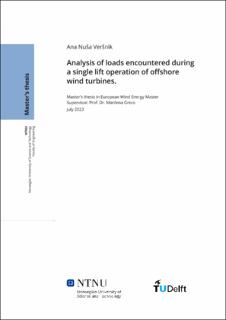| dc.description.abstract | The success of offshore wind farm installations is often related to the costs and time taken to be completed. Current installation strategies require several critical offshore lifts for the completion of a single wind turbine, as in most cases each component gets installed separately. This is time-consuming and has a direct link to the cost of the operation. Therefore trying to find more efficient methods of offshore wind turbine installation should be one of the main focuses in the industry. A possible solution to the problem involves the single-lift wind turbine installation. For this method, the whole wind turbine is pre-assembled and lifted onto the offshore foundation with one lift. This way the number of critical lifts offshore is reduced, which has the potential to reduce overall installation time and cost. The downside of this method is that, for the lifting of a whole wind turbine, very calm environmental conditions are required, leading to low workability. Calm environmental conditions do not often occur at offshore wind farm locations, and hence, solutions to improving the workability of this particular method are required to make it competitive with current installation methods.
The solution proposed in this thesis is to utilise the Upper Stabiliser Frame (USF), a Heerema Marine Contractors concept, which helps to eliminate unwanted motions of the wind turbine while in the air. The frame gets mounted at a height on the tower above the combined centre of gravity of the whole wind turbine. Since this frame is only a concept, its exact effect on the installation has not yet been studied in detail, and the actual design of the frame has not yet been fully developed. Therefore, the aim of this thesis was to analyse the loads experienced by the whole system (floating vessel and wind turbine) during such an installation and to investigate how the USF frame could be designed to constrain the relative rotation between the tower and the USF.
To reach the objective of the thesis, various analyses were conducted in LiftDyn, an in-house Heerema software, and OrcaFlex, where the whole system, or parts of the system, were investigated. A modal analysis and frequency domain analysis were done in LiftDyn while time domain analyses of different environmental loads were performed in OrcaFlex. The response of the system was examined, and based on the results, the maximum yaw moment acting on the tower under limiting environmental conditions was determined.
The results of the investigation showed that the WTG motions are limiting for safe operation and lead to very low acceptable environmental conditions compared to other installation methods. Based on these conditions, the maximum tower yaw-moment recorded was 2100 kNm. This moment was transformed into a tangential force acting on the tower, which the frame had to counteract. Two possible designs of the USF, both utilising friction, were created. The first design consisted of friction pads spaced around the circumference of the tower, while the second used a band brake to deliver the necessary friction. A multi-criteria analysis with weighted factors was conducted to evaluate which design performed better. Based on this analysis, the band brake design showed better performance, making it the most suitable design for the USF.
The novel concept of the single lift installation strategy with the USF is still not ready to be used yet for real projects and will require further development to become competitive with currently used strategies. This thesis has formed the basis for further research in the field by identifying key problems that must be resolved and suggesting innovative solutions for the USF design. This installation strategy has the potential to revolutionise wind turbine installation by decreasing installation time, increasing operational efficiency, and in general, streamlining the whole process. | |
